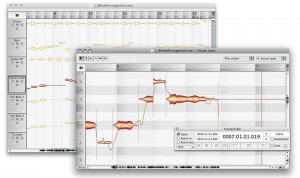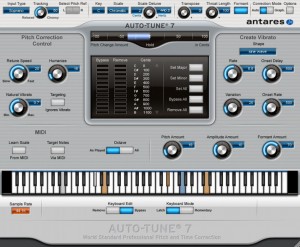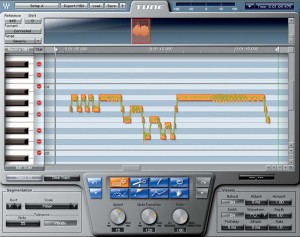Plugin Roundup: The Best Tuning Plugins and How To Use Them
Recording vocals is one of my favorite parts of working with new artists. When you do it, you become part coach, part psychologist, part tuning fork. With any luck, you can help new singers raise their own standards for themselves, listening on as they deliver lines with more conviction, confidence, and better pitch than where they started.
As much as our ideal is to capture the best performance possible (and to workshop parts with artists when pitches seems uncertain or just out-of-reach) there are those cases where time or budgetary constraints make it so that a little bit of after-the-fact tuning becomes something of a necessity. If massaging a note into place helps save an otherwise inspiring take, is it worth it?
Some producers, artists and engineers scoff at the idea of tuning software. It’s easy to understand the sentiment. The focus should be placed first be on performance, and even then, there’s a lot of music that benefits from being presented warts intact. But to take a hard line against tuning is to ignore that it is sometimes an economic necessity, mandated by shrinking time and resources devoted to record making and artist development. It is also to ignore that tuning software has become more than a tool for repair – It’s now a creative tool in its own right.
From non-invasive note correction to songified newscasts and vocoder-ized melodic hooks, tuning software is here to stay. Best to figure out how to use it, and what it can do. This week we present a roundup of three of the most popular tuning plugins, and evaluate their strengths and weaknesses.
(Street Prices: $69 “Essential”, $199 “Assistant”, $349 “Editor”, $699 “Studio”)
When Melodyne hit the scene in 2001, it changed what a tuning program could be. Today, it’s still arguably among the most powerful of the major tools in some ways.
Through its graphic editor, Melodyne allows control over every aspect of inflection, timing and pitch. It can do extremely transparent, uninvasive and almost imperceptible note correction, or it can achieve radical, synth-like effects. The program can export performances as MIDI data to be fed into a synthesizer, sampler, or virtual instrument,and as of 2008, it works in a nearly unique polyphonic mode.
Its greatest strengths – power, flexibility, and control – go hand-in-hand with its one weakness: Using Melodyne isn’t difficult, but depending on how you use it, can be time-consuming. What Melodyne doesn’t have is a fully “automatic” note correction mode. It instead invites you to correct individual notes or phrases manually. This can be a benefit, as it puts an emphasis on careful and selective tuning. But it can also be a hinderance if you have a whole lot of tuning to do in a rush.
The program is at its quickest and easiest when it’s used to zoom in on just one note or two within a performance. Once you “track” a portion of the performance in into the program’s memory, just, grab the note and simply slide it into the right place. Alternately, you can use the “correct pitch” button to automate the process somewhat, specifying the percentage to which you’d like to fix the note or minimize warbling. When you’re working on just a note or two in this way, Melodyne actually has an advantage over a more automated tuning plugin when it comes to time.
Things get a little more time-intensive when you have several passages or whole phrases to work on. If you find yourself in a case where an entire section of a song needs either a little gentle tuning or some synthetic effect, then manually editing the performance can take some doing. In these situations, an automated plugin might have a slight edge.
Another disadvantage is that once you’ve used Melodyne to capture a passage, editing the underlying audio is only possible through the plugin itself unless you print your changes through a bus and back into your DAW. It’s best to apply the plugin after all other edits have been made, and to make sure it’s the first processor in your chain.
There’s also danger in growing addicted to the power and control of the program and going down the rabbit hole. Once you’ve heard how transparent it can sound to take one bum note that’s 20 cents flat and slide it right into pitch, it’s hard not to go cruising for more notes to tweak. When you have such an elegant hammer in your hand, the temptation to go around looking for nails becomes very great indeed.
Still, Melodyne is definitely worth the effort. It excels at subtlety, includes a “formant” function allows you to reshape the timbre of the source sound, its modulation tool allows you to create synth-like effects and its MIDI export feature can be a great creative tool.
What’s most unique are the plugin’s polyphonic capabilities. Melodyne’s pitch correction can be applied, not just to one melodic note at a time, but to individual notes within a chord. Reaching into a strummed guitar chord to intonate a single note or change the 3rd from major to minor is something that can seem unbelievable, even after you’ve done it a few times.
In 2012, a company called Zynaptiq released the first real-time polyphonic pitch editor, and Apple filed its own patents for a polyphonic editor for Logic, but at the present date, competition remains limited on this front.
(Street Prices: $299 Native; $599 TDM)
Auto-Tune is the one that started it all. From Cher and T-Pain to songified Presidential debates and TV shows, some of the most obvious tuning effects we hear in popular media can be attributed to the use of Auto-Tune.
Although it’s most associated with these extreme effects, Auto-Tune can also go subtle. Since Melodyne came on the scene, Auto-Tune has added a full-featured graphical editor of its own. But what still sets the program apart is its automatic real-time mode.
If you’re tuning an entire performance, this allows for a “set-it and forget-it” kind of operation that’s especially ideal for quickly creating dramatic effects or smoothing out background vocal layers without much fuss.
Auto-Tune lacks a MIDI export function. However, it can accept MIDI input, making it great for songifying monotonous stretches of sound in real-time or creating guide tracks. Auto-Tune also has one of the more pleasant-looking user interfaces around, with clean sleek lines and well-organized screen space.
What you won’t fine in Auto-Tune is Melodyne’s polyphonic mode. But for producers and engineers working with pop artists on making especially polished and processed-sounding music, Auto-Tune’s algorithm is almost expected. Its realtime mode also makes the program practical for live performance. (Hey, it’s a step up from Milli Vanilli, and how would you expect T-Pain or Lil Wayne to put on a concert without it?).
If you want to get really heavy into vocal synthesis and Antares offers some vocal effects that can be bundled together with Auto-Tune 7, such as its harmony generator, alienifying “Mutator” plugin, and a pretty effective digital talk box.
(Street Prices: “LT” Version $199, Full Version $399
Waves’ Tune plugin is a lot like Auto-Tune in that it offers both a graphical and automatic real-time operation. It sounds at least as transparent as Melodyne, and does over-the-top late 2000s T-Pain kitsch just as well and as quickly as Auto-Tune can.
When it comes to MIDI control, Tune goes both ways, offering both input and output, whereas Melodyne and Auto-Tune just offer one or the other. The interface is clean and straightforward, but perhaps a little small compared Melodyne’s, which can make the graphical mode a little awkward to navigate.
On a Native system, both Auto-Tune and Melodyne have a bit of a leg up on Tune in the price department, but when you consider that Tune can come bundled with other Waves plugs, that advantage begins to fade. Tune is easily on or above par with Auto-Tune in both features and sound.
Which One is Right For You?
For my own work, I might put Waves Tune slightly ahead of Auto-Tune on the list, as I’ve found the results can be even more inaudible with slightly less effort.
If you’re accustomed to the specific sound of Auto-Tune and are doing genre-specific work that demands that effect, none of the other plugins sound exactly like it. And it’s still a top choice for “songifying” non-melodic material.
What still leads the pack for me in my own personal work is Melodyne, due to its power, tweakability. polyphonic option, and its welcome limitations. When doing simple fixes of a note or two at a time, I like not having the automated realtime option, and instead working with one of the largest and most comprehensive graphical editors.
But with that said, any of these plugins can get the job done. To find out what works best for you, each of these companies offers a generous trail period: 7 days for Waves Tune, 10 days for Antares Auto-Tune, and a whopping 30 days for celemony’s Melodyne.
Whatever your thoughts are on tuning plugins – lifesaving advance of science, necessary evil, creative tool, bane of good music everywhere – it’s clear that they’ve become an indispensable part of the working engineer’s toolkit. Today, there are some jobs that just can’t be completed without them.
Tuning software is no longer our future. It’s our present. There’s no law that says you have to like it – But chances are that if you’re an engineer-for-hire, it’s in your best interest to accept it, at the very least. And, if you’re ever going to use it, do yourself the favor of learning how to use it well.










Greg Thomas
July 25, 2013 at 5:16 pm (11 years ago)I’d be curious to know how you think the built-in tuning capabilities in Digital Performer and (now) Logic compare with these plug-ins. For me, Melodyne and Auto-Tune were always too much of a pain and too time-consuming to use. Even when working in another DAW, I’ve always used DP for tuning due to its ease of use.
Adam Gershon
July 26, 2013 at 7:27 am (11 years ago)Good overview, Justin. Melodyne is definitely king in terms of features. Just wanted to mention that I use Melodyne’s export-to-midi feature for drum replacement/triggering, too.
Good Loops
September 9, 2013 at 9:26 am (11 years ago)Melodyne becomes even more powerful when using the polyphonic version on acoustic guitar loops for example.
This will make your existing library extremely flexible:
For the TV and commercial music producer I’ve made a little tutorial video on how to use our loops, but it really works with any audio material.
http://www.hanshafner.de/sl/80
Would be great it you stopped by our website and took a look at our Guitar Kitchen Vol. 1 acoustic guitar loop sample library.
hrflikk
December 20, 2015 at 7:39 am (9 years ago)Melodyne ant auto tune is CRAP compared for what vst i use.. but i will not say it…
pressdabest
March 4, 2016 at 5:23 am (9 years ago)Ur a weirdo sir
john smart ass
January 29, 2017 at 1:38 am (8 years ago)dang your so lucky man